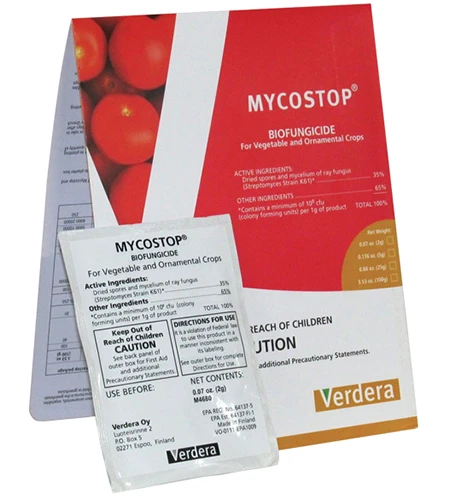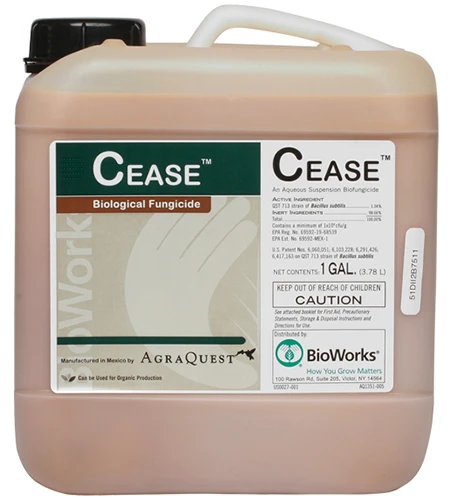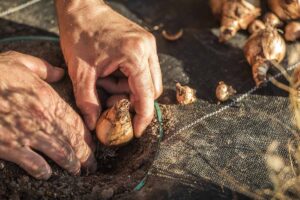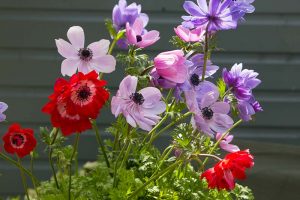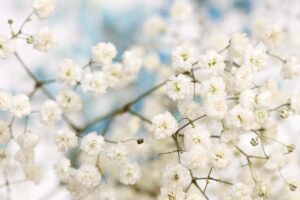That intoxicating scent – jasmine is unlike anything else, and it’s no wonder you can find it in so many gardens.
While it’s not a particularly delicate plant, it can suffer from several diseases, which range from truly no big deal to downright devastating.

We link to vendors to help you find relevant products. If you buy from one of our links, we may earn a commission.
Give it something to climb up, regular food and water, and protect it from strong wind, and most of the time you’ll be enjoying the delicate pinwheels and their instantly-identifiable fragrance, for years to come.
That is, unless a disease ruins your fun. Here’s the lineup of diseases that we’re going to go over in this guide, to help keep your plants healthy:
7 Common Jasmine Diseases
Remember that a healthy vine or shrub is always more able to resist problems. Do your best to support your plant and keep pests out of the scene.
You can learn more about how to grow and care for jasmine in our guide.
If, despite your best efforts, one of these pathogens sneaks in, early treatment will give it the best chance for recovery.
Here we go!
1. Crown Gall
Sometimes you know something is wrong with your plant, but you just can’t put your finger on it.
If it just seems to lack the usual vigorous growth you’re used to or that you’ve come to expect, examine the base of the plant closely.
If you see little lumps and bumps on the lower trunk and stems, it’s likely your plant is infected with the bacteria Agrobacterium tumefaciens, which causes a disease known as crown gall in jasmine.
As the plant ages, the galls grow in size. They aren’t just ugly, but they seriously restrict how much water the plant can take up.
The bacteria lives in the soil and it has hundreds of host species. It gets into the plant through wounds caused by tools, breakage, or insect damage.
The only way to get rid of it in the soil is to heat it above 160°F for 30 minutes, which isn’t really a great option for home growers.
Instead, you can pull the plant, or treat the galls using a product that contains A. tumefaciens strain K84. In other words, give it a bit of a dose of its own medicine.
Arbico Organics carries a product called Procidic that contains this beneficial bacteria, and it’s effective at treating galls – but the faster you get to work, the better.
Pick some up in a 16-ounce concentrate, 32-ounce ready-to-use spray, or a gallon-size concentrate for big jobs.
2. Leaf Blight
If you begin to notice reddish-brown spots on the upper side of the leaves, particularly if it’s been rainy or you’ve been watering the foliage rather than at the soil level, it’s likely leaf blight.
Caused by both Cercospora jasminicoloa and Alternaria jasmini fungi, when left unchecked, blight causes the leaves to curl up.
Next, the edges of the leaves turn brown and die. The brown areas will spread until the entire leaf is dead.
New shoots and buds will turn brown and die too.
Use a Bordeaux mixture spray regularly throughout the wet season, and take care only to water at the soil level.
3. Mosaic Virus
While relatively uncommon except in warmer areas like Florida and Hawaii, jasmine plants are subject to mosaic virus.
If you’ve ever seen mosaic virus symptoms on other species before, then you know what to look for. In addition to stunted growth, the leaves develop angular yellow stripes and patches.
There are many different viruses that can cause these symptoms in jasmine, including tobacco ringspot virus (TRSV), arabis mosaic virus (ArMV), cucumber mosaic virus, jasminum chlorotic ringspot virus (JCRSV), jasmine virus H (JaVH), and jasmine mosaic-associated virus (JMaV).
For our purposes, they’re all handled the same, so don’t worry about how on earth you’re going to figure out which one is causing your woes.
Since mosaic disease is spread either vegetatively through cuttings or plant divisions, or by insects, you have two ways to avoid it.
The first is to buy certified disease-free plants and to look them over carefully before bringing them into your garden. The same goes for any cuttings or divisions you accept from friends or neighbors.
Second, keep pests like whiteflies out of your garden. I know it’s easier said than done, but all it takes is one infected whitefly to feed on your jasmine, and it’s too late.
Once you see symptoms, all you can do is remove the plant.
You could opt to prune off any symptomatic areas, but then you run the risk of spreading mosaic disease to lots of other species in your garden, since many of these viruses have multiple host species.
4. Phyllody
Phyllody is such a strange condition. Typically spread by whiteflies and caused by a virus, this disease causes strange growth patterns, like small leaves and unusually bushy vines.
The plant won’t be able to form any new flowers. Instead, it will put out strange leaf-like structures.
In other words, instead of producing those magnificent blossoms, your jasmine vine will produce funky leaves instead.
There isn’t any known way to eliminate this disease. All you can do is cut out the infected parts and hope for the best.
Prevention is crucial, and that involves keeping whiteflies out of your garden as much as you’re able to.
But there’s more bad news.
Phyllody can also be a physiological condition brought on by hormonal changes in the plant driven by stress rather than infection by a pathogen.
So even keeping pests away isn’t a sure-fire guarantee that you’ll be able to avoid it. Keep proper cultivation practices in mind for the healthiest plants.
5. Rot
When I lived in the desert, I hardly ever dealt with root rot unless some kind of accident happened, like an irrigation hose broke and flooded my garden. Now I’m living in a rainforest, and rot is a regular occurrence.
That should tell you how important it is to avoid overwatering and how vital it is to plant jasmine in well-draining soil!
Root rot is caused by Sclerotium rolfsii and the symptoms begin on the older leaves first. These will turn yellow, followed by newer leaves. Next, the leaves turn brown and fall off the plant.
At the same time, you might see white fungal strands on the soil or lower parts of the plant.
If you see any of these symptoms, dig down and expose the roots. If they’re black and mushy, it’s root rot, and you must act fast.
Copper fungicide used as a soil drench is effective if you start treatment early. Once a majority of the roots have rot, it might be too late to save the plant.
6. Rust
Rust in jasmine plants is caused by the fungus Urornyces hobsoni, which impacts many ornamental and edible species.
Rust is an easy disease to identify because the fungus causes characteristic orange pustules that do indeed look a lot like your plant has started rusting.
These appear on the undersides of the leaves and petals, and might also appear on flower buds and twigs in advanced infections.
As the infection progresses, the leaves, buds, and twigs become distorted. Try to act well before this phase, because it’s much easier to address the problem early on.
Your standard copper or sulfur fungicide is effective against the disease if you take care to coat both the upper and lower sides of the leaves and flowers. Mancozeb will also control the infection.
Bonide Liquid Copper Fungicide
You will likely need to reapply multiple times following the manufacturer’s directions.
Pick up Bonide’s Liquid Copper Fungicide at Arbico Organics in 32-ounce ready-to-use bottles, 16- or 32-ounce hose end sprays, or a 16-ounce concentrate.
7. Wilt
Fusarium solani attacks all kinds of plants (and humans, in the case of fusariosis), and the fungus is found in soil the world over. At some point, most of us will encounter it in our gardens, but it doesn’t always cause a big problem.
Fusarium wilt in jasmine plants typically starts when the weather warms and the temperature climbs above 75°F. Infected plants will be stunted, and the leaves might turn yellow, starting with the lower leaves first.
Part or all of the plant will start wilting and eventually die.
Because it’s so prevalent, we’ve developed some pretty good ways of dealing with fusarium, but the trick is to mix things up. If you use the same treatment over and over, the fungi will develop immunity, and then you’re right back where you started.
I have had good luck with Mycostop, which is a biofungicide that utilizes a bacterium derived from sphagnum moss called Streptomyces strain K61.
This product is available at Arbico Organics in five- and 25-gram packs.
Just know that it doesn’t store long after you open it, so you’re better off buying multiple small packs rather than one large one, unless you’re treating a lot of plants.
If you catch the problem early, you can use this as a soil soak just once, or reapply a second time after two weeks have passed, and it will effectively address the issue.
If the disease is further along, with wilt already showing, treat twice with Mycostop and then move on to something else. Again, rotating fungicides to prevent resistance is a good idea.
A product that contains the beneficial bacteria Bacillus subtilis is also effective. Use this for two treatments spaced two weeks apart and then switch back to the original product, if needed.
CEASE contains this powerful bacterium and is also available at Arbico Organics in gallon- or two-and-a-half-gallon options.
Ditch the Diseases
Diseases are a part of gardening. No matter how careful and diligent you are, chances are high that you will have to deal with one or more of them at some point.
But take heart – jasmine is generally easygoing, and now you have the knowledge you need so you’ll know what to watch for.

Which one of these annoying issues are you dealing with? What symptoms are you seeing? Are you finding success with getting rid of it? Share your drama with us in the comments so we and other readers can learn and help.
Can’t get enough? Learn more about growing jasmine in these guides:


